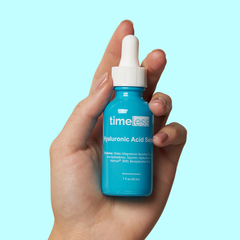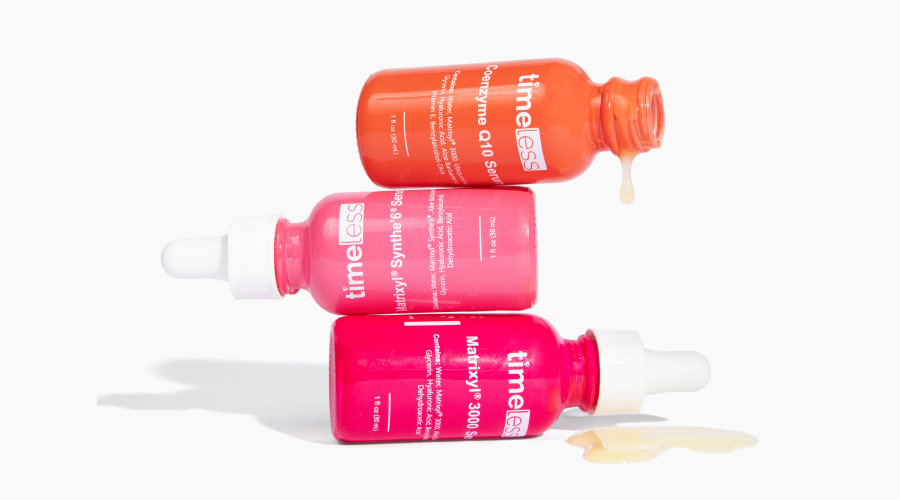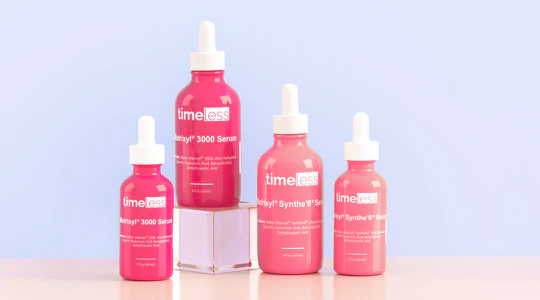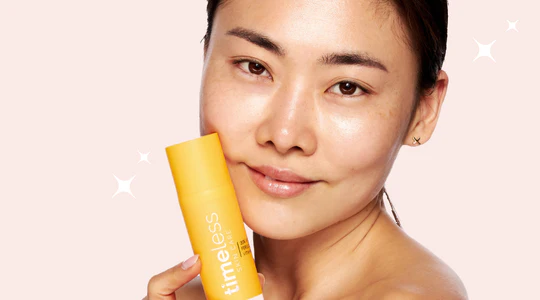Hyaluronic Acid has become a cult product for getting on your glow factor. Synonymous with hydration, Hyaluronic Acid runs the gauntlet from plumping and increasing volume, minimizing the appearance of wrinkles, and helping with skin elasticity! With so many benefits, many of us are wondering ‘how do I incorporate Hyaluronic Acid into my skincare routine?’
What is Hyaluronic Acid?
As a naturally occurring complex sugar in our body, especially for our skin, Hyaluronic Acid gradually decreases as we age. Topically, Hyaluronic Acid works as a humectant, renowned for its unique ability to attract and hold up to 1000 times its weight in water. Timeless Hyaluronic Acid 100% Pure uses a 1% concentration of sodium hyaluronate, which equates to 100% Hyaluronic Acid. Any higher concentration would actually gel up and dry out the skin, instead of delivering maximum permeability to help hydrate the face.
Hyaluronic Acid and Dehydrated Skin
Since Hyaluronic Acid attracts moisture, be careful how you use pure Hyaluronic Acid on dehydrated skin. In dry climates, especially in winter months, using just Hyaluronic Acid on dry skin can actually make it more thirsty, tight-feeling and crackled. When Hyaluronic Acid can’t draw moisture out of the air, it can actually start sucking moisture out of your skin.
This is why it’s so important to know how to use Hyaluronic Acid as a moisturizer, and how to incorporate Hyaluronic Acid into your skincare routine.
Here are the top 3 tips for using Hyaluronic Acid in your skincare routine:
- If applying Pure Hyaluronic Acid on its own, always apply on slightly damp skin to help bind the moisture to your skin.
- Hyaluronic Acid assists in the delivery of active ingredients across the skin, so layer with your favorite serum for extra hydrating benefits.
- Seal in Hyaluronic Acid with a layer of facial oil, such as squalane oil, then finish with a moisturizer.
What types of Skin can use Pure Hyaluronic Acid?
Any skin types can use pure Hyaluronic Acid, it’s super light and watery, assisting in the delivery of active ingredients across the skin. Hyaluronic Acid 100% Pure is also the perfect clean ingredient for sensitive skin as well as oily or acne prone skin. Applying Hyaluronic Acid regularly can signal the body to produce less oil, helping to stop the vicious cycle of over-exfoliating and drying out the skin, which then triggers it to produce even more oil.
Can you use Vitamin C serum and Hyaluronic Acid together?
Yes, these two make an excellent power duo! Hyaluronic Acid helps to soothe and hydrate the skin barrier after the application of Vitamin C. You can also combine Hyaluronic Acid Pure with a facial oil or moisturizer to help seal and fortify the skin barrier.
Can you use Retinol and Hyaluronic Acid together?
Yes, Hyaluronic Acid compliments Retinols (Vitamin A), hydrating and protecting the skin against the harsher effects of Vitamin A which can cause redness, flaking and irritation.
What about all three – can I use Retinol, Vitamin C and Hyaluronic Acid together?
As a rule, Retinol and Vitamin C don’t mix well together. Retinol works at a higher pH level compared to Vitamin C, which works more effectively at a lower acidic level.
Hyaluronic Acid can be safely combined with either ingredient, preferably Hyaluronic Acid with Retinol at night (since Vitamin A is prone to photosensitivity) and for daytime use, Hyaluronic Acid with Vitamin C is a great combination, helping to brighten, nourish and protect!
Try This Routine!
When it comes to getting the most out of your Hyaluronic Acid, here is a suggested order for applying products:
Step 1 - Serum(s)Step 2 - Hyaluronic Acid Pure - apply directly to the skin or mix with your moisturizer in Step 4Step 3 - Squalane Oil - use as a facial primer to seal in moisture and protect the skin from the environmentStep 4 - MoisturizerStep 5 - SPF
As Esthetician and Timeless Skin Care Education Specialist, Shelly Leggins says, “Just as water is to a sponge, applying Hyaluronic Acid serum topically helps plump up the skin. Hydrated skin is beautiful skin!”















